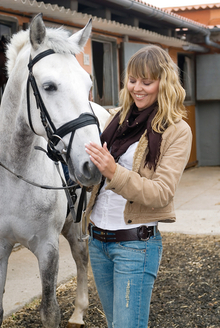What if we could be trained to see subtle changes in the horse's behavior that told us where the horse was hiding and holding tension? And what if we were able to by-pass the horse's survival instinct in a way that allowed it to release muscular tension accumulated in the course of his life and work?

Releasing horse's tension by touch
The two key parts of the Masterson Method principles and techniques aren't difficult to learn and enable the owner/handler to see subtle changes in the horse's behavior that tell where the horse is hiding and holding tension.
With the Masterson Method® you learn to by-pass the horse's survival response to enable the horse to release tension, and to communicate on the level of its own body language. The horse tells you where it is hiding tension and when it's being released. The process becomes something you are doing with the horse, rather than to the horse, and becomes not only more effective, and infinitely more rewarding and fulfilling.
The principles and techniques aren't difficult to learn. There are two key parts -
1) Learning how to recognize and follow subtle, and sometimes not-so-subtle, responses from the horse to your touch. These range from the subtlest softening or blinking of an eye (the horse's) to repeated snorting and sneezing, yawning, and rolling back of the second eyelid (again, the horse's.)
2) Learning to use a level of pressure, and sometime non-pressure, that the horse canât brace against. This can range from no pressure â what we call âair gapâ - to about as much pressure as you can use â what we call âhard lime.â The key is to stay under the horse's survival bracing response.
Once you know what to look for the horse will tell you when you are under its survival response, and when it has released the tension. You are in effect using the horse's parasympathetic nervous system to allow it to release tension.
With the popularity of equestrian sports growing around the world, interest in the benefits of equine massage is growing as well, and many equestrian competitors are seeing the value of regular bodywork on their horses.
The importance of this is not limited to competition horses. The family pony may have the most important job description in the household - to keep the children safe. Ponies are experts at camouflaging pain that may eventually be demonstrated as bad behavior and this can become the ultimate family heartbreak.
Learning how to read and use the horse's responses to touch to enable it to release pain and tension improves not only performance, but also relationship with your horse, which is ultimately what it's all about.
From Jane Savoie, Olympic Coach and Motivational Speaker: âJim Mastersonâs work is AMAZING! It is gentle, effective, and strengthens the bond and communication between you and your horse. For me, itâs the perfect combination of âphysical therapyâ from the ground and from the saddle.â
Jim Masterson, the official Equine Massage Therapist for the USET Endurance Team 2006-14, and for equine clientele competing in FEI World Cup, Pan American, and World Games competitions, developed a system in which the horse participates in the bodywork process.
The result is an effective method of bodywork that anyone can learn to use, to improve performance. Jim is the author of the bestselling Beyond Horse Massage Book and DVD and The Dressage Horse Optimized Book and several DVDâs including his newest: Light to the Core. Masterson Method seminars and advanced courses are available to horse owners, trainers, and therapists worldwide (mastersonmethod.com).
About The Masterson Method® of Integrated Equine Performance Bodywork:
The Masterson Method is an integrated, multi-modality method of equine massage. It is a unique, interactive method of equine massage in which you learn to recognize and use the responses of the horse to your touch to find and release accumulated tension in key junctions of the body that most affect performance.
In contrast to most traditional modalities, it enables the horse to actively participate in the process of releasing tension. It is something you do with the horse, rather than to the horse. This participation and interaction is what makes the method fascinating for those who use it. In fact, if you do not allow the horse to participate, it does not work.
